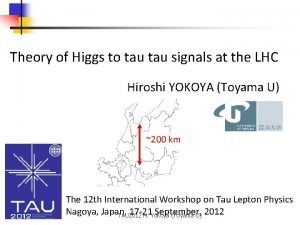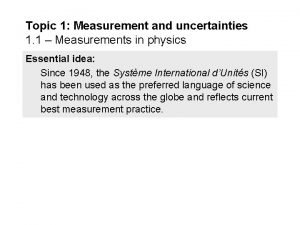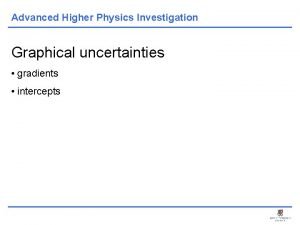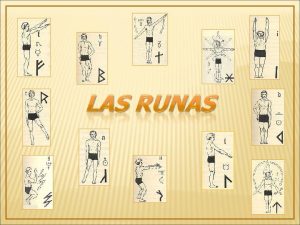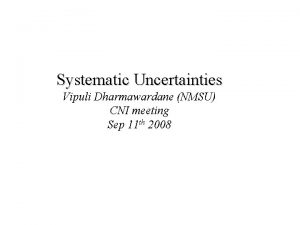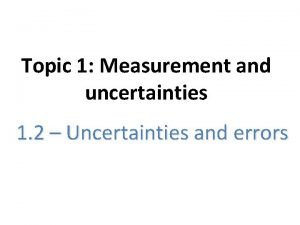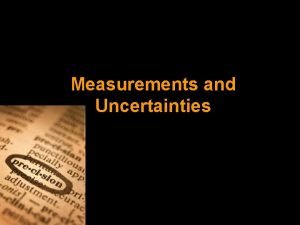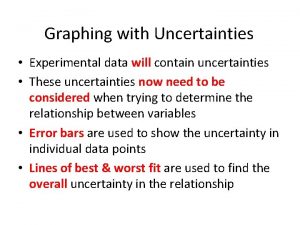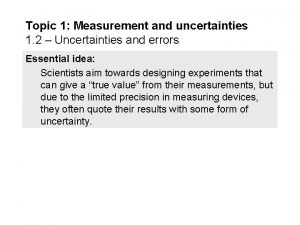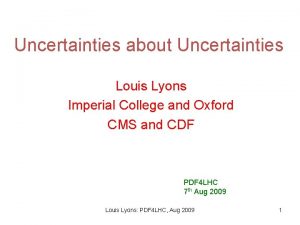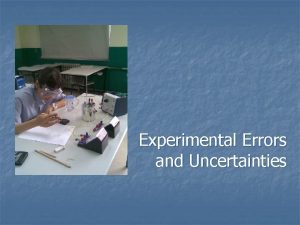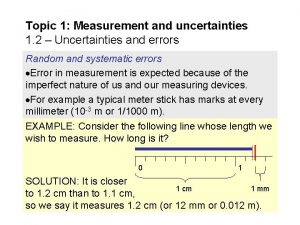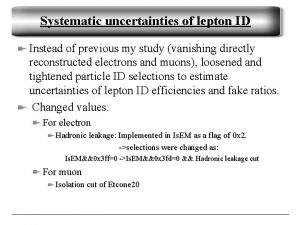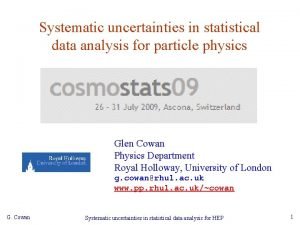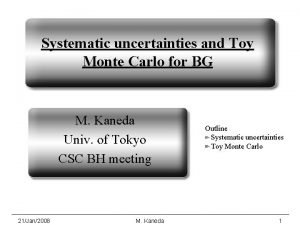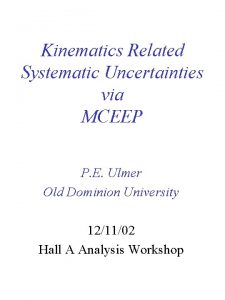TAU WG MEETING ALGORITHMS Systematic uncertainties on tau













- Slides: 13

TAU WG MEETING: ALGORITHMS. Systematic uncertainties on tau identification efficiency and QCD rejections. SUSANA CABRERA-URBÁN IFIC (CSIC-University of Valencia) TAU WG: ALGORITHMS 17 -12 -2007 SUSANA CABRERA-URBÁN 1

THE OUTLINE • Systematic uncertainties on the QCD rejections: – Proposed methodology to evaluate fake-rates from QCD dijet samples from ATL-COM-PHYS-2007 -066. – Preliminary “working assumptions”: first conservative systematics from ATL-COM-PHYS-2007 -066. – What needs to be done towards a more realistic estimate on jet tau fake rate systematics based on TEVATRON experience. • Systematic uncertainties on the tau identification efficiency: – Tau-ID MC comparisons: Z , W ν and tt-bar from ATLCOM-PHYS-2007 -066. – What needs to be done with real data based on TEVATRON experience. TAU WG: ALGORITHMS 17 -12 -2007 SUSANA CABRERA-URBÁN 2

FAKE-RATES FROM QCD DI-JET SAMPLES. • Evaluation of relative fake-rates: – ATL-COM-PHYS-2007 -066 ( Section 6. 2 , contribution from Will Davey, University of Melbourne) – F(ET) = NID/NRECO – NRECO : = reconstructed candidates. • For the time being, only TAUREC algorithm has been used (Tau. Jet´s in AOD´s ) – NID : = reconstructed candidates passing ID cuts. • ID cuts: TAUREC likelihood > 6 TAU WG: ALGORITHMS 17 -12 -2007 SUSANA CABRERA-URBÁN 3

FAKE-RATES FROM QCD DI-JET SAMPLES. • Brief reminder of the concepts: – NRECO = N RECO (real reconstructed ´s)+NJETS RECO (fake reconstructed ´s) – NID = N ID (real ´s passing ID cuts) +NJETSID (fake ´s passing ID cuts) – Tau ID Efficiency: e= N ID / N RECO – Tau FAKE-RATE: f= NJETSID / NJETS RECO • “Weighting method” for QCD background estimate: – NJETS ID = f / (e-f) (e. NRECO –N ID) – Each Tau Candidate is assign a weigth: • NRECO=1 by definition. • w= f/(e-f) x (e-1) if it passes ID cuts (NID=1) • w=f/(e-f) x(e-0) if it does not (NID=0) – Number of misidentified QCD jets in the real sample (signal + background) • NJETS ID = i=1, NRECO Wi TAU WG: ALGORITHMS 17 -12 -2007 SUSANA CABRERA-URBÁN 4

RELATIVE FAKE-RATES FUNCTIONS VERSUS ET FR O(1%): 0. 5 -3. 5% Needs of high statistics O(1 million) in J 0, J 1, J 2, J 3, J 4 for not statistically limitted estimate of relative FR(ET, ISO, SUMET) (Currently 400 K evt per sample) TAU WG: ALGORITHMS 17 -12 -2007 Landau fits for ET dependence SUSANA CABRERA-URBÁN 5

SYSTEMATICS ON FAKE RATES (I) TAU WG: ALGORITHMS 17 -12 -2007 SUSANA CABRERA-URBÁN 6

SYSTEMATICS ON FAKE-RATES (II) • A systematic uncertainty can be quoted from the relative difference between the true number of fake taus and the estimated number of fake taus. – The estimated number of fake taus is obtained from the combined prediction using J 0, 1, 2, 3, 4 landau-parameterised relative fake rate and “weighting method” described before. – In a single jet sample, we find differences of 60% AMONG the estimates using the J 0, 1, 2, 3, 4 landau-parameterized relative fake rates and diffferences up to 130% BETWEEN those estimates and the combined one. – This fact indicates that the relative fake rate needs to be parameterized NOT ONLY vs ET but also versus additional variables, in order to get consistency in the background predictions. – The true number of fake taus is obtained in each J 0, 1, 2, 3, 4 by summing all the tau candidates (reconstructed Tau. Jets by TAUREC) passing the ID. TAU WG: ALGORITHMS 17 -12 -2007 SUSANA CABRERA-URBÁN 7

RECOMMENDATIONS BASED ON THE TEVATRON EXPERIENCE. • SELECTING UNBIASED JETS in order to reduced the bias introduced by the trigger algorithms. – Trigger bias could cause 100% differences between relative fake rates computed from jet triggered data with different ET thresholds. – Ej: narrow jets or jets with more EOM energy versus HAD could more likely fired the trigger, could fake a hadronic tau decay with more or less probability. – CDF METHOD: REMOVE THE TRIGGER JET FROM THE TAU JET CANDIDATES • IDENTIFICATION OF THE JET TRIGGER: ΔR ( L 1(SINGLE TOWER) , L 2 (CLUSTERS), L 3 JETS – OFFLINE JET) < 0. 4 – “A Search for t ---> tau nu q in t anti-t production” Phys. Lett. B 639: 172, 2006, hepex/0510063 FERMILAB-PUB-05 -484 -E • • FR dependent NOT ONLY on ET but also the annular isolation fraction of the tau candidate: this could reduce differences from 100% to 20% in the estimates of number of fake taus in the DIJET samples. FR dependent NOT ONLY on ET but also the TOTAL ET (Sum. Et) of the event in order to get consistent prediction in the estimates of number of fake taus in the DIJET samples and W+JETS sample (triggered with inclusive high PT electron or muon) , MULTIJET samples, etc… – CDF/ANAL/TOP/PUBLIC/8376, Stephane Tourneur Aurore Savoy-Navarro “Search for ttbar -> tau + l +nunuqq” TAU WG: ALGORITHMS 17 -12 -2007 SUSANA CABRERA-URBÁN 8

CONCLUSIONS ON SYSTEMATICS FOR QCD REJECTIONS • Relative (JET ) fake rates for DIJET 0, 1, 2, 3, 4 PROPOSED parameterized versus ET need to be dependent PRELIMINARY Δ SYST on additional variables: SUMET or ISOLATION • The best systematic uncertainty from ΔSYST TEVATRON is 26% using DIJET data and 200 E T ( Ge. V) pb-1 ( N evt=6 M, 2 M, 1 M in QCD data samples J 0 (8 -17) 26% JET 20, 50, 70 and SUMET) • The cross section for QCD DIJETS increases J 1 (17 -35) 41% roughly by a factor 50 -100 from TEVATRON to LHC. 3% 26% J 2 (35 -70) – In the first 100 pb-1 in ATLAS there should be (CDF) enough statistics in the DIJET samples in order J 3 (70 -140) not to suffer from limited statistics. – The extrapolation of the systematic uncertainty J 4 (140 -280) from L=100 pb-1 to L=1 fb-1, 10 fb-1 it is not a matter of statistics ( it does not scale with integrated luminosity: ΔSYST/√LINT ) but understanding the differences between the relative fake rates from J 10, 18, 23, 35, 42 etc data samples. TAU WG: ALGORITHMS 17 -12 -2007 SUSANA CABRERA-URBÁN 24% 41% 9

Systematics on -ID efficiency: Z & W ν • -ID efficiency: – ΔR=0. 2 BETWEEN truth visible hadronic at the generator level and tau jet candidate passing -ID • ATL-COM-PHYS-2007 -066 ( Section 9. 2. 3 , contribution from J. Tanaka, Tokyo Univ ) • Likelihood-based Tau. Rec: – Eff(Z )≈50%, Eff(W ν)≈45% – Δ(Z , W ν) ≈ 10% • For cut-based Tau. Rec: – Eff(Z )≈42%, Eff(W ν)≈42% – Δ(Z , W ν) ≈ negligible • For Tau 1 p 3 p, discri. Cut: – Eff(Z )≈35%, Eff(W ν)≈33% – Δ(Z , W ν) ≈5% TAU WG: ALGORITHMS 17 -12 -2007 SUSANA CABRERA-URBÁN 10

Systematics on -ID efficiency: tt-bar W(e/µ)b. W( had)b • ATL-COM-PHYS-2007 -066 ( Section 9. 3. 1 , contribution from S. Cabrera IFIC(CSIC-U. of. Valencia) ) Tau-ID eff from cut-flow • For Tau 1 p 3 p, discri. Cut: • Eff(Z )≈35%, Eff(W ν)≈33% • Δ(Z , W ν) ≈5% • Eff(tt-bar) ≈40% • Δ(Z , ttbar) ≈ 12. 5% TAU WG: ALGORITHMS 17 -12 -2007 SUSANA CABRERA-URBÁN 11

CONCLUSIONS on -ID efficency systematics. • Likelihood Tau. Rec and discri. Cut Tau 1 P 3 P: – Systematic uncertainty quoted comparing different MC samples: Z , W ν, ttbar. • Likelihood Tau. Rec : 10% (Z versus W ν) • Discri. Cut Tau 1 p 3 p: 12. 5 % ( W ν versus ttbar) • At the TEVATRON: Tau ID systematic uncertainty estimated from differences DATA-MC in expected (MC) and observed Nevt (W ν) : 5 -10% • The isolation requirement in the annulus ( “annular isolation fraction” in ATLAS) causes inefficiencies dominated by the underlaying event tracks and occasional nearby tracks. The main systematic comes from modelling the underlaying event in the simulation. TAU WG: ALGORITHMS 17 -12 -2007 SUSANA CABRERA-URBÁN 12

QCD samples: TEVATRON vs LHC @CDF Minimum pthat (Ge. V/c) XS(mb) NEVT in MC & DATA(200 pb-1) @ATLAS Pt-hat (Ge. V/c) XS(mb) NEVT in MC samples 18 Ge. V/c 4. 988 X 10 -2 6 M 8 -17 17. 6 400 K 40 Ge. V/c 1. 330 X 10 -3 6 M 17 -35 1. 38 400 K 60 Ge. V/c 1. 78 X 10 -4 1. 4 M 35 -70 0. 093 400 K 90 Ge. V/c 2. 059 X 10 -5 1. 4 M 70 -140 0. 0058 400 K 120 Ge. V/c 3. 956 X 10 -6 2 M 140 -280 0. 000308 400 K 150 Ge. V/c 1. 009 X 10 -6 2 M 280 -560 0. 0000125 400 K TAU WG: ALGORITHMS 17 -12 -2007 SUSANA CABRERA-URBÁN 13
 Higgs to tau tau
Higgs to tau tau Relative uncertainty
Relative uncertainty Measurement topic
Measurement topic Uncertainties higher physics
Uncertainties higher physics Advanced higher physics uncertainties
Advanced higher physics uncertainties What is meeting and types of meeting
What is meeting and types of meeting For today's meeting
For today's meeting Today meeting or today's meeting
Today meeting or today's meeting What is meeting and types of meeting
What is meeting and types of meeting Tau vs titans
Tau vs titans Karakia for meetings
Karakia for meetings Sen tau
Sen tau Runa not
Runa not Alfabeto grego
Alfabeto grego
